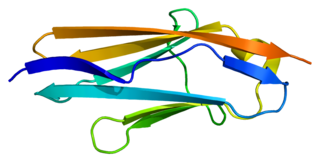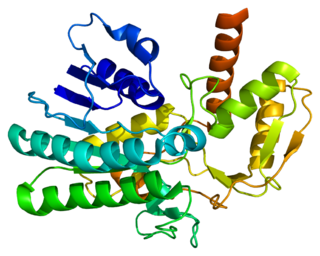
NEDD8-activating enzyme E1 catalytic subunit is a protein that in humans is encoded by the UBA3 gene.

Cdc42 effector protein 3 is a protein that in humans is encoded by the CDC42EP3 gene.

Proton-coupled amino acid transporter 1 is a protein that in humans is encoded by the SLC36A1 gene.

Trafficking kinesin-binding protein 1 is a protein that in humans is encoded by the TRAK1 gene.

60S ribosomal protein L36 is a protein that in humans is encoded by the RPL36 gene.

DnaJ homolog subfamily B member 9 is a protein that in humans is encoded by the DNAJB9 gene.

BAG family molecular chaperone regulator 2 is a protein that in humans is encoded by the BAG2 gene.

E3 ubiquitin-protein ligase RNF123 is an enzyme that in humans is encoded by the RNF123 gene.

CpG-binding protein (CGBP) also known as CXXC-type zinc finger protein 1 (CXXC1) or PHD finger and CXXC domain-containing protein 1 (PCCX1) is a protein that in humans is encoded by the CXXC1 gene.

N-terminal acetyltransferase B complex catalytic subunit NAT5 is an enzyme that in humans is encoded by the NAT5 gene.

Diphosphoinositol polyphosphate phosphohydrolase 3-beta is an enzyme that in humans is encoded by the NUDT11 gene.

Striated muscle preferentially expressed protein kinase, in the human is encoded by the SPEG gene, a member of the myosin light chain kinase protein family. SPEG is involved in the development of the muscle cell cytoskeleton, and the expression of this gene has important roles in the development of skeletal muscles, and their maintenance and function. Mutations are associated with centronuclear myopathies a group of congenital disorders where the cell nuclei are abnormally centrally placed.

Zinc transporter 7 is a protein that in humans is encoded by the SLC30A7 gene.

Gamma-1-syntrophin is a protein that in humans is encoded by the SNTG1 gene.

UDP-glucuronic acid decarboxylase 1 is an enzyme that in humans is encoded by the UXS1 gene.

Zinc finger protein 346 is a protein that in humans is encoded by the ZNF346 gene.

Ras-associating and dilute domain-containing protein is a protein that in humans is encoded by the RADIL gene.

COMM domain-containing protein 9 is a protein that in humans is encoded by the COMMD9 gene.

Thioredoxin domain-containing protein 2 is a protein that in humans is encoded by the TXNDC2 gene.

Lysosomal thioesterase PPT2 (PPT-2), also known as S-thioesterase G14, is an enzyme that in humans is encoded by the PPT2 gene.




















